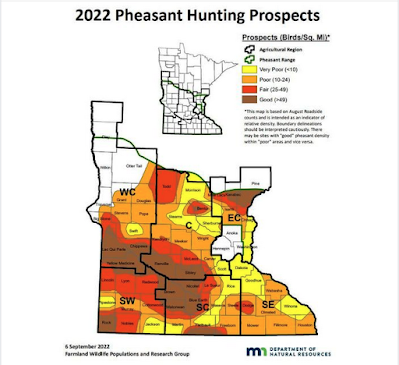North Dakota’s roadside surveys conducted in late July and August indicate pheasant and gray partridge were up from last year, while sharp-tailed grouse numbers were down.
State Game and Fish Department upland game supervisor Jesse Kolar said the annual upland late summer counts showed mixed results. “We observed an increase in pheasant and partridge densities and reproductive rates with average brood size and age ratios, while sharptails decreased in density but had improved reproductive rates from 2021,” Kolar said.
Total pheasants (49) observed per 100 miles are up 9% from last year and broods (5.3) per 100 miles are up 8%. The average brood size (6.2) is up 7%. The final summary is based on 278 survey runs made along 100 brood routes across North Dakota.
Observers in the northwest counted 11 broods and 96 pheasants per 100 miles, up from eight broods and 68 pheasants in 2021. Average brood size was six.
Results from the southeast showed five broods and 39 pheasants per 100 miles, up from three broods and 24 pheasants in 2021. Average brood size was five.
Statistics from southwestern North Dakota indicated five broods and 48 pheasants per 100 miles, down from six broods and 59 pheasants in 2021. Average brood size was five chicks.
The northeast district, generally containing secondary pheasant habitat with lower pheasant numbers compared to the rest of the state, showed two broods and 18 pheasants per 100 miles, compared to three broods and 24 pheasants last year. Average brood size was seven.
Kolar said sharptail hunters should expect to find more hatch-year grouse this fall.
“The rangeland vegetation is significantly taller, and there will be many more areas to search to find grouse,” he added. “However, we have not had significant amounts of precipitation since mid-July, upland rangelands may not be as productive as hillsides or low-lying riparian areas, particularly if the fall remains hot. Although the densities were highest in the southwest, the relative trends remain highest in the prairie potholes along the Missouri River.”
Sharptails observed per 100 miles are down 30% statewide. Brood survey results show observers recorded two sharptail broods and 13 sharptails per 100 miles. Average brood size was six.
Generally, Kolar said, most of the partridge harvest is incidental while hunters pursue grouse or pheasants. But this year, with partridge numbers looking impressive, he said there may be pockets where hunters could focus primarily on partridge.
“Huns have rebounded, and the last time they were this good was in 2015,” Kolar said.
Partridge observed per 100 miles are up 46%. Observers recorded one partridge brood and 12 partridge per 100 miles. Average brood size was 10.
The grouse and partridge seasons open Sept. 10 and continue through Jan. 1, 2023.
The pheasant season opens Oct. 8 and continues through Jan. 1, 2023. The two-day youth pheasant hunting weekend, when legally licensed residents and nonresidents 15 and younger can hunt statewide, is set for Oct. 1-2.


